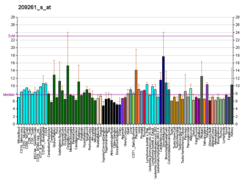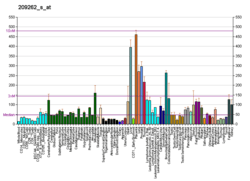V-erbA-related gene
V-erbA-related protein 2 (EAR-2) also known as NR2F6 (nuclear receptor subfamily 2 group F member 6) is a protein that in humans is encoded by the NR2F6 gene.[5] V-erbA-related protein 2 is a member of the nuclear receptor family of intracellular transcription factors. It is named after its similarity to v-erbA (P03373), a helper of an oncoprotein called v-erbB in avian erythroblastosis virus.[6]
Function
Comparatively little is known about ear-2, but it has been shown to function as a coregulator of other nuclear receptors.[7][8]
Nr2f6 knockout mice show defects in development of the locus ceruleus.[9]
It was found that antigen receptor stimulation-induced NF-AT/AP-1 activity is regulated through the nuclear receptor NR2F6 (NR2F6 acts as a direct repressor of NF-AT/AP-1 transactivation) and that by preventing NR2F6 function, transcriptional activation of NF-AT/AP-1 is enhanced in immune cells which leads to an augmented immune response.[10]
NR2F6 impairs the formation of mature red blood cells in animals that over-express NR2F6 in their bone marrow. Mice that over expression of NR2F6 in their bone marrow cells have a block at the pro-erythroblast stage of blood cell development both in the bone marrow and in the spleen of animals that have excessive expression of NR2F6. So, when inhibition of differentiation of stem cell is desired, inhibition of differentiation is achieved through induction of increased NR2F6 activity. In situations where differentiation of stem cells into a cell of increased maturity is desired, inhibition of NR2F6 activity must be performed.[11]
Clinical significance
It was found that expression of NR2F6 was consistently upregulated in neoplastic tissues in leukemic, ovarian cancer and endometrial cancer as compared to non-malignant tissues, while the silencing of NR2F6 induces a reduction of cancer cell proliferation, inhibiting clonogenicity and self-renewal of proliferating cancer cells, and induces differentiation.[12]
Interactions
V-erbA-related gene has been shown to interact with:
References
- GRCh38: Ensembl release 89: ENSG00000160113 - Ensembl, May 2017
- GRCm38: Ensembl release 89: ENSMUSG00000002393 - Ensembl, May 2017
- "Human PubMed Reference:". National Center for Biotechnology Information, U.S. National Library of Medicine.
- "Mouse PubMed Reference:". National Center for Biotechnology Information, U.S. National Library of Medicine.
- Miyajima N, Kadowaki Y, Fukushige S, Shimizu S, Semba K, Yamanashi Y, Matsubara K, Toyoshima K, Yamamoto T (December 1988). "Identification of two novel members of erbA superfamily by molecular cloning: the gene products of the two are highly related to each other". Nucleic Acids Research. 16 (23): 11057–74. doi:10.1093/nar/16.23.11057. PMC 338996. PMID 2905047.
- Thormeyer, D; Baniahmad, A (October 1999). "The v-erbA oncogene (review)". International Journal of Molecular Medicine. 4 (4): 351–8. PMID 10493974.
- Zhu XG, Park KS, Kaneshige M, Bhat MK, Zhu Q, Mariash CN, McPhie P, Cheng SY (April 2000). "The orphan nuclear receptor Ear-2 is a negative coregulator for thyroid hormone nuclear receptor function". Molecular and Cellular Biology. 20 (7): 2604–18. doi:10.1128/MCB.20.7.2604-2618.2000. PMC 85476. PMID 10713182.
- Liu X, Huang X, Sigmund CD (May 2003). "Identification of a nuclear orphan receptor (Ear2) as a negative regulator of renin gene transcription". Circulation Research. 92 (9): 1033–40. doi:10.1161/01.RES.0000071355.82009.43. PMID 12690040.
- Warnecke M, Oster H, Revelli JP, Alvarez-Bolado G, Eichele G (March 2005). "Abnormal development of the locus coeruleus in Ear2(Nr2f6)-deficient mice impairs the functionality of the forebrain clock and affects nociception". Genes & Development. 19 (5): 614–25. doi:10.1101/gad.317905. PMC 551581. PMID 15741322.
- Baier, G. and Hermann-Kleiter, N., Medizinische Universitat Innsbruck, (2011). Antagonists of NR2F6 For Augmenting The Immune Response. U.S. Patent Application 13/004,781.
- Ichim, C.V. and Ichim, T., (2015). Modulation of Hematopoietic Stem Cell Differentiation. U.S. Patent 20,150,299,712.
- Ichim, C. V. (2015). Methods and Compositions for treatment of cancer by inhibition of NR2F6 U.S. Patent No. 20,150,291,964. Washington, DC: U.S. Patent and Trademark Office.
- Avram D, Ishmael JE, Nevrivy DJ, Peterson VJ, Lee SH, Dowell P, Leid M (May 1999). "Heterodimeric interactions between chicken ovalbumin upstream promoter-transcription factor family members ARP1 and ear2". The Journal of Biological Chemistry. 274 (20): 14331–6. doi:10.1074/jbc.274.20.14331. PMC 2823254. PMID 10318855.
Further reading
- Bähler M, Kehrer I, Gordon L, Stoffler HE, Olsen AS (July 1997). "Physical mapping of human myosin-IXB (MYO9B), the human orthologue of the rat myosin myr 5, to chromosome 19p13.1". Genomics. 43 (1): 107–9. doi:10.1006/geno.1997.4776. PMID 9226381.
- Avram D, Ishmael JE, Nevrivy DJ, Peterson VJ, Lee SH, Dowell P, Leid M (May 1999). "Heterodimeric interactions between chicken ovalbumin upstream promoter-transcription factor family members ARP1 and ear2". The Journal of Biological Chemistry. 274 (20): 14331–6. doi:10.1074/jbc.274.20.14331. PMC 2823254. PMID 10318855.
- Zhang Y, Dufau ML (January 2000). "Nuclear orphan receptors regulate transcription of the gene for the human luteinizing hormone receptor". The Journal of Biological Chemistry. 275 (4): 2763–70. doi:10.1074/jbc.275.4.2763. PMID 10644740.
- Zhu XG, Park KS, Kaneshige M, Bhat MK, Zhu Q, Mariash CN, McPhie P, Cheng SY (April 2000). "The orphan nuclear receptor Ear-2 is a negative coregulator for thyroid hormone nuclear receptor function". Molecular and Cellular Biology. 20 (7): 2604–18. doi:10.1128/MCB.20.7.2604-2618.2000. PMC 85476. PMID 10713182.
- Liu X, Huang X, Sigmund CD (May 2003). "Identification of a nuclear orphan receptor (Ear2) as a negative regulator of renin gene transcription". Circulation Research. 92 (9): 1033–40. doi:10.1161/01.RES.0000071355.82009.43. PMID 12690040.
- Beausoleil SA, Jedrychowski M, Schwartz D, Elias JE, Villén J, Li J, Cohn MA, Cantley LC, Gygi SP (August 2004). "Large-scale characterization of HeLa cell nuclear phosphoproteins". Proceedings of the National Academy of Sciences of the United States of America. 101 (33): 12130–5. Bibcode:2004PNAS..10112130B. doi:10.1073/pnas.0404720101. PMC 514446. PMID 15302935.
External links
- NR2F6+protein,+human at the US National Library of Medicine Medical Subject Headings (MeSH)





